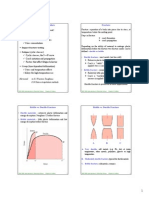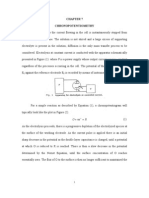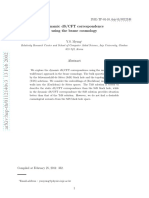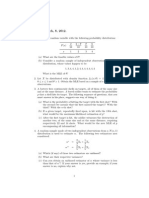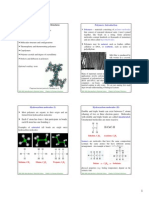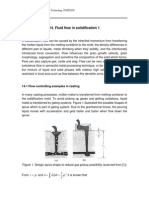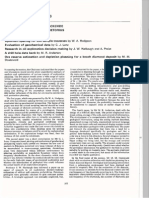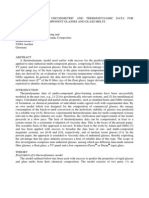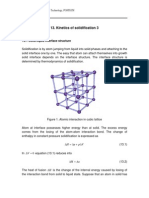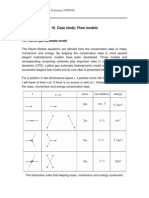Dendritic Growth: 17.1 Formation of Dendrite
Uploaded by
Anonymous T02GVGzBDendritic Growth: 17.1 Formation of Dendrite
Uploaded by
Anonymous T02GVGzBGraduate Institute of Ferrous Technology, POSTECH
Rongshan Qin (R. S. Qin)
17. Dendritic growth
17.1 Formation of dendrite
The morphology of a growing particle during solidification depends on the moving
velocity of the solid-liquid interface. For a planar solid-liquid interface as
illustrated in figure 1a, the planar shape will maintain if every points in the
interface move with the same speed. For any perturbation to the interface, if the
perturbation growth as the time evolution, the planar solid-liquid interface will turn
into fractal shape, as illustrated in figure 1b. The grain with fractal morphology is
called dendrite. Interface at the situation is called instable. On the contrary, the
interface where perturbation decays as the time evolution is stable. The planar
interface will remain its shape, as illustrated in figure 1c.
Figure 1. Interface instability. (b) Instable. (c) Stable.
17.2 Mullins and Sekerka theory [1, 2]
The stability of a planar interface has been studied systematically by Mullins and
Sekerka. They considered a planar interface moving along z-axis with constant
Graduate Institute of Ferrous Technology, POSTECH
Rongshan Qin (R. S. Qin)
velocity V, The perturbation is supposed as a sinusoidal ripple of infinitesimal
amplitude described by the equation
( ) ( ) ( ) x t t x z sin , = = (17.1)
where (t) is the amplitude, is the frequency of the sinusoidal ripple. =2/ is
the wave length. The interface stability is judged by dt d /
&
. 0 >
&
means that
the ripple grows and 0 <
&
means that the ripple decays. The coordinate is
showed in figure 2.
Figure 2. The coordinate for equation (17.1)
The moving velocity, v(x), of the sinusoidal ripple is given determined by the
gradients of temperature and solute concentration and is given by
( )
(
(
\
|
\
|
=
z
T
K
z
T
K
L
x v
L
L
S
s
S
1
(17.2)
( )
( )
|
\
|
=
z
c
k c
D
x v
L
1
*
(17.3)
where L is the heat of fusion.
S
is the density of solid metal. K
S
and K
L
are heat
conductivity of solid and liquid metals, respectively. T
S
and T
L
are temperature at
solid and liquid side of interface, respectively. c
L
* is equilibrium composition in
liquid. k is the equilibrium partition ratio which is given by k= c
S
*/c
L
*. D is the
solute diffusivity.
Graduate Institute of Ferrous Technology, POSTECH
Rongshan Qin (R. S. Qin)
The average moving rate of the solid-liquid interface, which is the average growth
rate of the solid, is an average of v(x) in one wavelength.
( )
0
1
dx x v V (17.4)
In a coordinate frame that moves with velocity V and with the origin at z=0, the
steady-state equations of the solute composition and temperature are
( )( ) 0 / /
2
= + z c D V c (17.5)
( )( ) 0 / /
2
= + z T V T
L
(17.6)
( )( ) 0 / /
2
= + z T V T
S
(17.7)
where
L
and
S
are thermal diffusivity of liquid and solid metals. For the
geometry of sinusoidal ripple, we suppose that the temperature and
concentration at the interface takes the expressions of
( ) ( )
a T x t a T T + = + =
0 0
sin (17.8)
( ) ( )
b c x t b c c + = + =
0 0
sin (17.9)
where T
0
and c
0
are the values for a flat interface and the second terms are the
first-order corrections corresponding to the infinitesimal ripple. By reference of
(6.15), we know that the steady state solution of equations (17.5)-(17.7) for flat
interface is in a format of
( )z D V
Be A
/
+ . We, therefore, assume that the solutions
of equations (17.5)-(17.7) in sinusoidal ripple interface are
( ) ( )
( )
( ) ( ) ( )
0
* /
sin 1 / , c e x G b e V D G z x c
z w
c
z D V
c
+ + =
(17.10)
( ) ( )
( )
( ) ( ) ( )
0
* /
sin 1 / , T e x G A e V G z x T
z w
c
z V
S S S
S S
+ + =
(17.11)
( ) ( )
( )
( ) ( ) ( )
0
* /
sin 1 / , T e x G A e V G z x T
z w
L
z V
L L L
L L
+ + =
(17.12)
Graduate Institute of Ferrous Technology, POSTECH
Rongshan Qin (R. S. Qin)
where G
S
and G
L
are thermal gradients at unperturbed flat interface in the solid
and liquid, respectively. G
c
is the concentration gradient in the liquid at the
unperturbed flat interface. Insulting (17.10) into (17.5) we have
0 * *
2 2
= w w
D
V
w (17.13)
which means that (17.5) will be satisfied by the solution of (17.10) when
2
2
2 2
* +
|
\
|
+ =
D
V
D
V
(17.14)
Similarly, we have
2
2
2 2
*
L
L L
L
V V
+
|
|
\
|
+ = (17.15)
and
2
2
2 2
*
S
S S
S
V V
+
|
|
\
|
+ = (17.16)
Equation (17.10) gives gradient of the diffusion fields at the interface to the first
order in
( ) ( )
( ) ( )
( )
( ) [ ] { } ( )
c c
x w
c
x D V
c
G x D V G b w
e x G b w e G
z
c
+
=
|
\
|
sin * / 1 *
sin *
sin * sin /
(17.17)
Similarly, (17.11) and (17.12) gives
( ) [ ] { } ( )
L L L L L
L
G x V G a w
z
T
+
|
\
|
sin * / 1 * (17.18)
and ( ) [ ] { } ( )
S S S S S
S
G x V G a w
z
T
+
|
\
|
sin * / 1 * (17.19)
Graduate Institute of Ferrous Technology, POSTECH
Rongshan Qin (R. S. Qin)
The solution for temperature should also satisfy the Gibbs-Thomson effect on the
curvature contribution. In dilute binary system, the Gibbs-Thomson effect gives
the temperature at curved interface as the format of following.
( ) x T T mc
x
z
T T mc K T T mc T
m m m m m m
sin
2
2
2
+ =
|
|
\
|
+ + = + + = (17.20)
where m is the slope of the liquidus at z=. T
m
is the melting temperature of pure
materials where c=0. is the capillary length.
Bring equations (17.17)-(17.19) into (17.2) and (17.3) and using the boundaty
condition of (17.20), it has
( ) ( ) [ ]( )
( ) ( ) [ ] p D V mG
D V G G T G
b
L S c
L S c L S c m c
/ * 2
/ * 2
3
+
+ + +
=
(17.21)
and
2
=
m
T mb a (17.22)
where ( ) [ ]
S L S S S
G K K K + = 2 / , ( ) [ ]
L L S L L
G K K K + = 2 / and p=1-k. Finally we
have
( ) [ ] ( ) ( ) [ ] ( ) [ ] { }
( ) ( ) [ ] p D V mG
D V mG p D V p D V T V
L S c
c L S m
/ * 2
/ * 2 / * / * 2
2
+
+ +
=
&
(17.23)
As mentioned before, the interface stability is determined by
&
. 0 >
&
implies the
instability of the interface and dendrite will grow.
17.3 Instability analysis
For to discuss equation (17.23), let us first see the phase diagram and
temperature/solute concentration distribution profiles in solidification. The phase
diagram of dilute alloy is illustrated in figure 3a. The corresponding solute
concentration profile is demonstrated in figure 3b. It can be see that the slope of
the liquidus and the gradient of solute concentration always has the same sign.
Graduate Institute of Ferrous Technology, POSTECH
Rongshan Qin (R. S. Qin)
This means that the first term in the denominator of equation (17.23) is always
positive. Figure 3c shows the temperature profile in the solidifying alloys without
liquid supercooling. Figure 3d shows the temperature profile in the solidifying
alloys with supercooling. Both figure 3c and figure 3d shows that 0 >
L S
.
From equation (17.14),
2
2
2 2
* +
|
\
|
+ =
D
V
D
V
, one has 0 * >
D
V
.
Furthermore, one has 0 * > p
D
V
because of 0<p<1. All of a word, the
denominator of equation (17.23) is positive.
Figure 3
The numerator of equation (17.23) can be expressed as
( ) [ ] ( ) S p D V w V / * 2
We know that ( ) [ ] 0 / * 2 > p D V w V . The question of whether
&
>0 turns into the
question of whether S()>0.
( ) ( )
( ) [ ]
( ) [ ] p D V
D V
mG T S
c L S m
/ *
/ *
2
2
+ + =
(17.24)
Graduate Institute of Ferrous Technology, POSTECH
Rongshan Qin (R. S. Qin)
S(() contains three terms. The first term is related to interface energy. The first term is
always negative because the interfacial energy is always in positive. The larger interface
energy possesses more stable interface. The second term is about the gradient of
temperature around interface. The positive gradient of temperature around interface helps
to maintain interface stable. The negative temperature gradient will cause the instability
of the solid-liquid interface. The third term is about the effect of solute diffusion on the
interface stability. When V/D<<1, the third term approaches to
c
mG 2 . If we ignore the
contribution from the interface energy, S()<0 will be satisfied when
( )
c L S
mG > +
2
1
(17.25)
References
1. W.W. Mullins and R.F. Sekerka, J. Appl. Phys., 35 (1964) 444-451.
2. W.W. Mullins and R.F. Sekerka, J. Appl. Phys., 34 (1963) 323-329.
You might also like
- Chapter Outline: Failure Fracture: How Do Materials Break?No ratings yetChapter Outline: Failure Fracture: How Do Materials Break?9 pages
- Point Admittance of An Infinite Thin Elastic Plate Under Fluid LoadingNo ratings yetPoint Admittance of An Infinite Thin Elastic Plate Under Fluid Loading3 pages
- 2.7 Aerosols and Coagulation: 2.7.1 Brownian Diffusion of ParticlesNo ratings yet2.7 Aerosols and Coagulation: 2.7.1 Brownian Diffusion of Particles8 pages
- A Numerical Scheme For Unsteady Flow of A Viscous Fluid Between Elliptic PlatesNo ratings yetA Numerical Scheme For Unsteady Flow of A Viscous Fluid Between Elliptic Plates5 pages
- MIT OCW Wave Propagation Lecture Part 3No ratings yetMIT OCW Wave Propagation Lecture Part 347 pages
- Performance of Tuned Liquid Dampers With Different Tank Geometries For Vibration Control of StructuresNo ratings yetPerformance of Tuned Liquid Dampers With Different Tank Geometries For Vibration Control of Structures9 pages
- Applied Mathematics of Fluid Flow in Porous MediaNo ratings yetApplied Mathematics of Fluid Flow in Porous Media94 pages
- J. Electroanal. Chem., 101 (1979) 19 - 28No ratings yetJ. Electroanal. Chem., 101 (1979) 19 - 2810 pages
- Density of States in Graphene: Periodic Boundary ConditionNo ratings yetDensity of States in Graphene: Periodic Boundary Condition7 pages
- Dynamic DS/CFT Correspondence Using The Brane Cosmology: INJE-TP-01-10, Hep-Th/0112140No ratings yetDynamic DS/CFT Correspondence Using The Brane Cosmology: INJE-TP-01-10, Hep-Th/011214013 pages
- Analysis of Time Rates of Primary Consolidation For The Simplest CaseNo ratings yetAnalysis of Time Rates of Primary Consolidation For The Simplest Case21 pages
- Balint Toth - Upper Bound On The Condensate in The Hard-Core Bose Lattice GasNo ratings yetBalint Toth - Upper Bound On The Condensate in The Hard-Core Bose Lattice Gas6 pages
- Comprehension - PDF - Electronic Devices and Analog Circuits - Electronic Devices and Analog CircuitsNo ratings yetComprehension - PDF - Electronic Devices and Analog Circuits - Electronic Devices and Analog Circuits36 pages
- Simultaneous Heat and Mass Transfer PresentationNo ratings yetSimultaneous Heat and Mass Transfer Presentation29 pages
- J_T_KATSIKADELIS-E_J_SAPOUNTZAKIS_A_BEM_solution_to_dynamic_analysis_of_plates_with_variable_thickness_(1991)No ratings yetJ_T_KATSIKADELIS-E_J_SAPOUNTZAKIS_A_BEM_solution_to_dynamic_analysis_of_plates_with_variable_thickness_(1991)11 pages
- Electric Field and Charge at The Corner or Edge: Masahiro YamamotoNo ratings yetElectric Field and Charge at The Corner or Edge: Masahiro Yamamoto3 pages
- First-Order Quantum Correction To The Ground-State Energy Density of Two-Dimensional Hard-Sphere Bose AtomsNo ratings yetFirst-Order Quantum Correction To The Ground-State Energy Density of Two-Dimensional Hard-Sphere Bose Atoms9 pages
- DETERIORATION OF SHORT CHANNEL EFFECTS IN DUAL HALO BASED TRIPLE MATERIAL SURROUNDING GATE (DH-TMSG) MOSFETNo ratings yetDETERIORATION OF SHORT CHANNEL EFFECTS IN DUAL HALO BASED TRIPLE MATERIAL SURROUNDING GATE (DH-TMSG) MOSFET8 pages
- Drift-Diffusion Model: Introduction: Dragica VasileskaNo ratings yetDrift-Diffusion Model: Introduction: Dragica Vasileska9 pages
- Excitons in Bulk and Low-Dimensional SemiconductorsNo ratings yetExcitons in Bulk and Low-Dimensional Semiconductors9 pages
- Chapter 17 (4/29/04) Thermal Neutron Scattering Basics - ReferencesNo ratings yetChapter 17 (4/29/04) Thermal Neutron Scattering Basics - References10 pages
- Dielectric Slab Waveguides: 17.1 Generalized Transverse Resonance ConditionNo ratings yetDielectric Slab Waveguides: 17.1 Generalized Transverse Resonance Condition10 pages
- Distance-Redshift Relations in An Anisotropic Cosmological ModelNo ratings yetDistance-Redshift Relations in An Anisotropic Cosmological Model8 pages
- Boundary Layer Growth of A Micropolar FluidNo ratings yetBoundary Layer Growth of A Micropolar Fluid7 pages
- Mass Transport of Visco-Elastic Electrodes: Hardeep Singh TejaNo ratings yetMass Transport of Visco-Elastic Electrodes: Hardeep Singh Teja3 pages
- On The Global Existence For The Muskat Problem: DOI 10.4171/JEMS/360No ratings yetOn The Global Existence For The Muskat Problem: DOI 10.4171/JEMS/36027 pages
- Long-Wave Instability in Double-Diffusive Marangoni ConvectionNo ratings yetLong-Wave Instability in Double-Diffusive Marangoni Convection18 pages
- Feynman Lectures Simplified 2C: Electromagnetism: in Relativity & in Dense MatterFrom EverandFeynman Lectures Simplified 2C: Electromagnetism: in Relativity & in Dense MatterNo ratings yet
- Burdukova Et Al. 2006. Effect of CMC and PH On The Rheology of Suspensions of Isotropic and Anisotropic MineralsNo ratings yetBurdukova Et Al. 2006. Effect of CMC and PH On The Rheology of Suspensions of Isotropic and Anisotropic Minerals15 pages
- Copper Flotation: Metals and Minerals IndustryNo ratings yetCopper Flotation: Metals and Minerals Industry2 pages
- Exploration Analysis: Evaluation of Geochemical Data C. JNo ratings yetExploration Analysis: Evaluation of Geochemical Data C. J2 pages
- Solidification Processing: Lecture 10: Thermodynamics 3No ratings yetSolidification Processing: Lecture 10: Thermodynamics 317 pages
- Phase Field Models: Graduate Institute of Ferrous Technology, POSTECH Rongshan Qin (R. S. Qin)No ratings yetPhase Field Models: Graduate Institute of Ferrous Technology, POSTECH Rongshan Qin (R. S. Qin)10 pages
- Kinetics of Solidification 3: 13.1 Solid-Liquid Interface StructureNo ratings yetKinetics of Solidification 3: 13.1 Solid-Liquid Interface Structure7 pages
- Heat Transfer: Graduate Institute of Ferrous Technology, POSTECH Rongshan Qin (R. S. Qin)No ratings yetHeat Transfer: Graduate Institute of Ferrous Technology, POSTECH Rongshan Qin (R. S. Qin)8 pages
- Case Study: Flow Models: 16.1 Lattice-Gas Automata ModelNo ratings yetCase Study: Flow Models: 16.1 Lattice-Gas Automata Model9 pages
- Aschenbrenner 1964-Aesthetics and Logic - An AnalogyNo ratings yetAschenbrenner 1964-Aesthetics and Logic - An Analogy18 pages
- James Tour, Leading Scientist and Darwin Skeptic PDFNo ratings yetJames Tour, Leading Scientist and Darwin Skeptic PDF3 pages
- A Research For An Earthquake Proof 2-Storey Residential BuildingNo ratings yetA Research For An Earthquake Proof 2-Storey Residential Building3 pages
- Collaboration Specialist Training v2 - Cisco Endpoints: About This LabNo ratings yetCollaboration Specialist Training v2 - Cisco Endpoints: About This Lab48 pages
- Chapter Outline: Failure Fracture: How Do Materials Break?Chapter Outline: Failure Fracture: How Do Materials Break?
- Point Admittance of An Infinite Thin Elastic Plate Under Fluid LoadingPoint Admittance of An Infinite Thin Elastic Plate Under Fluid Loading
- 2.7 Aerosols and Coagulation: 2.7.1 Brownian Diffusion of Particles2.7 Aerosols and Coagulation: 2.7.1 Brownian Diffusion of Particles
- A Numerical Scheme For Unsteady Flow of A Viscous Fluid Between Elliptic PlatesA Numerical Scheme For Unsteady Flow of A Viscous Fluid Between Elliptic Plates
- Performance of Tuned Liquid Dampers With Different Tank Geometries For Vibration Control of StructuresPerformance of Tuned Liquid Dampers With Different Tank Geometries For Vibration Control of Structures
- Density of States in Graphene: Periodic Boundary ConditionDensity of States in Graphene: Periodic Boundary Condition
- Dynamic DS/CFT Correspondence Using The Brane Cosmology: INJE-TP-01-10, Hep-Th/0112140Dynamic DS/CFT Correspondence Using The Brane Cosmology: INJE-TP-01-10, Hep-Th/0112140
- Analysis of Time Rates of Primary Consolidation For The Simplest CaseAnalysis of Time Rates of Primary Consolidation For The Simplest Case
- Balint Toth - Upper Bound On The Condensate in The Hard-Core Bose Lattice GasBalint Toth - Upper Bound On The Condensate in The Hard-Core Bose Lattice Gas
- Comprehension - PDF - Electronic Devices and Analog Circuits - Electronic Devices and Analog CircuitsComprehension - PDF - Electronic Devices and Analog Circuits - Electronic Devices and Analog Circuits
- J_T_KATSIKADELIS-E_J_SAPOUNTZAKIS_A_BEM_solution_to_dynamic_analysis_of_plates_with_variable_thickness_(1991)J_T_KATSIKADELIS-E_J_SAPOUNTZAKIS_A_BEM_solution_to_dynamic_analysis_of_plates_with_variable_thickness_(1991)
- Electric Field and Charge at The Corner or Edge: Masahiro YamamotoElectric Field and Charge at The Corner or Edge: Masahiro Yamamoto
- First-Order Quantum Correction To The Ground-State Energy Density of Two-Dimensional Hard-Sphere Bose AtomsFirst-Order Quantum Correction To The Ground-State Energy Density of Two-Dimensional Hard-Sphere Bose Atoms
- DETERIORATION OF SHORT CHANNEL EFFECTS IN DUAL HALO BASED TRIPLE MATERIAL SURROUNDING GATE (DH-TMSG) MOSFETDETERIORATION OF SHORT CHANNEL EFFECTS IN DUAL HALO BASED TRIPLE MATERIAL SURROUNDING GATE (DH-TMSG) MOSFET
- Drift-Diffusion Model: Introduction: Dragica VasileskaDrift-Diffusion Model: Introduction: Dragica Vasileska
- Excitons in Bulk and Low-Dimensional SemiconductorsExcitons in Bulk and Low-Dimensional Semiconductors
- Chapter 17 (4/29/04) Thermal Neutron Scattering Basics - ReferencesChapter 17 (4/29/04) Thermal Neutron Scattering Basics - References
- Dielectric Slab Waveguides: 17.1 Generalized Transverse Resonance ConditionDielectric Slab Waveguides: 17.1 Generalized Transverse Resonance Condition
- Distance-Redshift Relations in An Anisotropic Cosmological ModelDistance-Redshift Relations in An Anisotropic Cosmological Model
- Mass Transport of Visco-Elastic Electrodes: Hardeep Singh TejaMass Transport of Visco-Elastic Electrodes: Hardeep Singh Teja
- On The Global Existence For The Muskat Problem: DOI 10.4171/JEMS/360On The Global Existence For The Muskat Problem: DOI 10.4171/JEMS/360
- Long-Wave Instability in Double-Diffusive Marangoni ConvectionLong-Wave Instability in Double-Diffusive Marangoni Convection
- Constructed Layered Systems: Measurements and AnalysisFrom EverandConstructed Layered Systems: Measurements and Analysis
- Feynman Lectures Simplified 2C: Electromagnetism: in Relativity & in Dense MatterFrom EverandFeynman Lectures Simplified 2C: Electromagnetism: in Relativity & in Dense Matter
- Burdukova Et Al. 2006. Effect of CMC and PH On The Rheology of Suspensions of Isotropic and Anisotropic MineralsBurdukova Et Al. 2006. Effect of CMC and PH On The Rheology of Suspensions of Isotropic and Anisotropic Minerals
- Exploration Analysis: Evaluation of Geochemical Data C. JExploration Analysis: Evaluation of Geochemical Data C. J
- Solidification Processing: Lecture 10: Thermodynamics 3Solidification Processing: Lecture 10: Thermodynamics 3
- Phase Field Models: Graduate Institute of Ferrous Technology, POSTECH Rongshan Qin (R. S. Qin)Phase Field Models: Graduate Institute of Ferrous Technology, POSTECH Rongshan Qin (R. S. Qin)
- Kinetics of Solidification 3: 13.1 Solid-Liquid Interface StructureKinetics of Solidification 3: 13.1 Solid-Liquid Interface Structure
- Heat Transfer: Graduate Institute of Ferrous Technology, POSTECH Rongshan Qin (R. S. Qin)Heat Transfer: Graduate Institute of Ferrous Technology, POSTECH Rongshan Qin (R. S. Qin)
- Case Study: Flow Models: 16.1 Lattice-Gas Automata ModelCase Study: Flow Models: 16.1 Lattice-Gas Automata Model
- Aschenbrenner 1964-Aesthetics and Logic - An AnalogyAschenbrenner 1964-Aesthetics and Logic - An Analogy
- James Tour, Leading Scientist and Darwin Skeptic PDFJames Tour, Leading Scientist and Darwin Skeptic PDF
- A Research For An Earthquake Proof 2-Storey Residential BuildingA Research For An Earthquake Proof 2-Storey Residential Building
- Collaboration Specialist Training v2 - Cisco Endpoints: About This LabCollaboration Specialist Training v2 - Cisco Endpoints: About This Lab

